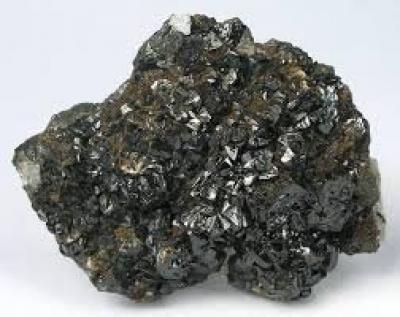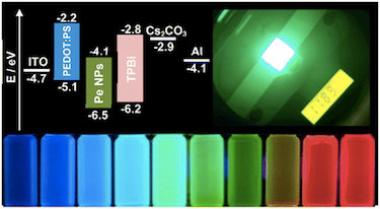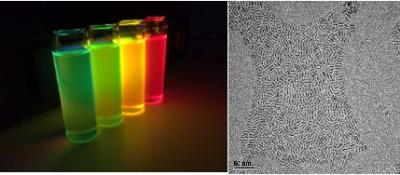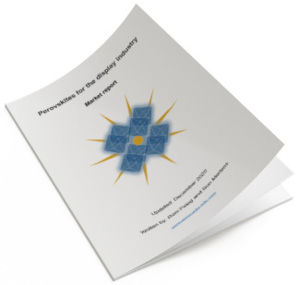Perovskite LED
What are perovskites?
Perovskite is a calcium titanium oxide mineral, with the chemical formula CaTiO3, discovered in the Ural Mountains of Russia by Gustav Rose in 1839 and named after Russian mineralogist Lev Perovski (1792–1856).

Perovskites are a class of materials with a similar structure that are easily synthesized and relatively low-cost. Perovskites are considered the future of solar cells and are also predicted to play a significant role in next-gen electric vehicle batteries, displays, sensors, lasers and much more.
Perovskites can have an impressive collection of interesting properties including “colossal magnetoresistance” - their electrical resistance changes when they are put in a magnetic field (which can be useful for microelectronics). Some Perovskites are superconductors, which means they can conduct electricity with no resistance at all. Perovskite materials exhibit many other interesting and intriguing properties. Ferroelectricity, charge ordering, spin dependent transport, high thermopower and the interplay of structural, magnetic and transport properties are commonly observed features in this family. Perovskites therefore hold exciting opportunities for physicists, chemists and material scientists.
What are LEDs?
A light-emitting diode (LED) is an electronic component that is essentially a two-lead semiconductor light source. It is a p–n junction diode that emits light upon activation by a voltage applied to the leads, which makes electrons recombine with electron holes within the device, releasing energy in the form of photons. This effect is called electroluminescence, and the color of the light is determined by the energy band gap of the chosen semiconductor.

LEDs’ advantages over incandescent light sources include lower energy consumption, longer lifetime, improved physical robustness, smaller size, and faster switching. Light-emitting diodes have become ubiquitous and are found in diverse applications in the aerospace and automotive industries, as well as in advertising, traffic signals, camera flashes and much more.
LEDs meant for general room lighting currently remain more expensive than fluorescent or incandescent sources of similar output, but are significantly more energy efficient.
What can perovskites do for LEDs?
Current high-quality LEDs are based on direct bandgap semiconductors, but making these devices is no easy task because they need to be processed at high temperatures and in vacuum, which makes them rather expensive to produce in large quantities. Perovskites that are direct-bandgap semiconductors could be real alternatives to other types of direct-bandgap materials for applications like color displays, since they are cheap and easy to make and can be easily tuned to emit light of a variety of colors.

Researchers have found that organometal halide-based perovskites (a combination of lead, organics and halogens that arrange into perovskite crystal structure in the solid state) could be very suitable for making optoelectronics devices, since they can be processed in solution and do not need to be heated to high temperatures. This means that large-area films of these materials can be deposited onto a wide range of flexible or rigid substrates. The perovskites also have an optical bandgap that can be tuned in the visible to infrared regions, which makes them very promising for a range of optoelectronics applications. These materials also emit light very strongly, which makes them very suitable for making LEDs. The light emitted by the perovskites can be easily tuned, which could make them ideal for color displays and lighting, and in optical communication applications.
However, a major obstacle that perovskites will have to overcome in order to be used in LED-type devices is that electrons and holes only weakly bind in perovskite thin films. This means that excitons (electron-hole pairs) spontaneously dissociate into free carriers in the bulk recombination layer, leading to low photoluminescence quantum efficiency (PLQE), high leakage current and low luminous efficiency. This obviously impairs perovskites’ ability to create high-performance LEDs, and for perovskite materials to make a comparable impact in light emission, it is necessary to overcome their slow radiative recombination kinetics. Simply put, researchers will have to find ways of effectively confining electrons and holes in the perovskite so that they can “recombine” to emit light. Major progress is already being made in this field, and it seems that perovskites will indeed open the door to a low-cost, color-tunable approach to LED development.
Recent work in the field of perovskite-based LEDs
In July 2016, researchers at Nanyang Technological University in Singapore have fabricated high-performance green light-emitting diodes based on colloidal organometal perovskite nanoparticles. The devices have a maximum luminous efficiency of 11.49 cd/A, a power efficiency of 7.84 lm/W and an external quantum efficiency of 3.8%. This value is said to be about 3.5 times higher than that of the best colloidal perovskite quantum-dot-based LEDs previously made.
In March 2016, researchers at the University of Toronto in Canada and ShangaiTech University in China have succeeded in using colloidal quantum dots in a high-mobility perovskite matrix to make a near-infrared (NIR) light-emitting diode (LED) with a record electroluminescence power conversion efficiency of nearly 5% for this type of device. The NIR LED could find use in applications such as night vision devices, biomedical imaging, optical communications and computing.
In February 2016, researchers from the Universitat Jaume I and the Universitat de València have studied the interaction of two materials, halide perovskite and quantum dots, revealing significant potential for the development of advanced LEDs and more efficient solar cells. The researchers quantified the "exciplex state" resulting from the coupling of halide perovskites and colloidal quantum dots, both known separately for their optoelectronic properties, but when combined, these materials yield longer wavelengths than can be achieved by either material alone, plus easy tuning properties that together have the potential to introduce important changes in LED and solar technologies.
In December 2015, researchers at Pohang University in Korea are reportedly the first to develop a perovskite light emitting diode (PeLED) that could replace organic LED (OLED) and quantum dot LED (QDLED).
Organic/inorganic hybrid perovskite have much higher color-purity at a lower cost compared to organic emitters and inorganic QD emitters. However, LEDs based on perovskite had previously shown a limited luminous efficiency, mainly due to significant exciton (a complex of an electron and hole that can allow light emission when it is radiatively recombined) dissociation in perovskite layers. The research team overcame the efficiency limitations of PeLED and boosted its efficiency to a level similar to that of phosphorescent OLEDs. This increase was attributed to fine stoichiometric tuning that prevents exciton dissociation, and to nanograin engineering that reduces perovskite grain size, and concomitantly decreases exciton diffusion length. PeLED might be a game changer in the display and solid-state lighting industries, with significantly improved efficiency as well as advantages like excellent color gamut and low material cost.
In November 2015, Florida State researchers have developed a cheaper, more efficient LED, or light-emitting diode, using perovskites. The researchers spent months using synthetic chemistry to fine-tune the materials in the lab, creating a perovskite material capable of emitting a staggering 10,000 candelas per square meter when powered by 12 volts. The scientists say that such exceptional brightness owes, to a large extent, to the inherent high luminescent efficiency of this surface-treated, highly crystalline nanomaterial.
New method enables researchers to engineer layered perovskite materials at the atomic level
Researchers at North Carolina State University and Brookhaven National Laboratory have reported a technique for engineering layered hybrid perovskites (LHPs) down to the atomic level, which enables precise control on how the materials convert electrical charge into light.
Image credit: Matter
The technique opens the door to engineering materials tailored for use in next-generation printed LEDs, lasers and photovoltaic devices.
Researches develop novel method to achieve efficient and stable blue perovskite LEDs
Soochow University researchers have proposed the in situ treatment of Cl-rich benzene phosphorus oxydichloride (BPOD)as a way to achieve high-quality pure-blue perovskites, by simultaneously enlarging the perovskite bandgap, passivating the halide vacancy defects, and immobilizing the halide ions through the hydrolysis products of chloride ions and phenylphosphonic acid.
The background for this work is that despite the substantial progress in sky-blue (480−495 nm) perovskite light-emitting diodes (PeLEDs), pure-blue PeLEDs (<480 nm) merely show moderate performances. Bromide-chloride mixed perovskites may have potential to enable a straightforward and effective way to obtain pure-blue emission, but the tricky issue of halide migration in mixed halide perovskites makes it challenging to achieve efficient PeLEDs with stable electroluminescence (EL) spectra.
Novel approach enables simple and efficient perovskite LEDs with record brightness
A team of researchers, led by Professor David Di from the International College of Zhejiang University and the School of Optoelectronic Science and Engineering, recently achieved a continuous transition from n-type to p-type perovskite semiconductors through molecular doping, while maintaining extremely high luminescence performance.
Image credit: Zhejiang University
Based on controllable doping, the team developed a perovskite LED with a simple structure and reported a record for the highest brightness of solution-based LEDs, reaching 1.16 million nits.
Novel method uses conjugated molecular multipods to produce efficient perovskite LEDs
Researchers from Seoul National University, University of Pennsylvania, Weizmann Institute of Science and Korea Basic Science Institute (KBSI) recently reported an advancement in the development of ultra-high efficiency perovskite nanocrystal light-emitting diodes (LEDs). Their work involved reinforcing the perovskite lattice and mitigating the material's natural low-frequency dynamics.
The team identified a critical challenge in the reduction of luminescence efficiency due to the ionic nature of perovskite. The weak ionic bonds in perovskite materials can cause large-amplitude displacement of atoms within the crystal lattice, resulting in dynamic disorder that interferes with the radiative recombination process, leading to exciton dissociation and decreased luminescence efficiency. Addressing this issue, however, has been underexplored until now. The team proposed a novel mechanism to enhance the luminescence efficiency of perovskite emitters by incorporating conjugated molecular multipods (CMMs). These CMMs bind to the perovskite lattice, strengthening it and reducing dynamic disorder, which in turn improves the luminescence efficiency.
New in situ fabrication technique could yield high-performance blue LEDs
Researchers from North China Electric Power University, Beijing University of Chemical Technology and Sichuan Normal University have created bright blue perovskite LEDs (PeLEDs), among the LED colors needed to enable commercial applications.
With high efficiency and stability, PeLEDs could be a promising new option for full-color displays and solid-state lighting technology. However, while red and green PeLEDs have nearly reached their theoretical external quantum efficiencies, blue PeLEDs do not yet reach the efficiency, stability, or luminosity required for commercial applications. The novel method presented in this work seeks to address this challenge. Using an in situ spin-coating method, the authors created Dion-Jacobson phase quasi-2D perovskite nanocrystals. A mixture of mixed inorganic cesium bromide and two organic bidentate molecules in the perovskite precursor solution regulates growth and crosslinking in the nanocrystals. The resulting perovskites demonstrated effective emission in PeLEDs, brightly glowing from sky blue to deep blue.
University of Groningen team develops strategy for blade-coated perovskite nanoplatelet polymer composites for sky-blue LEDs
Colloidal perovskite nanoplatelets (NPLs) have shown promise in tackling blue light-emitting diode challenges based on their tunable band gap and high photoluminescence efficiencies. However, high quality and large area dense NPL films have been proven quite hard to prepare due to their chemical and physical fragility during the liquid phase deposition.
Recently, researchers from University of Groningen reported a perovskite-polymer composite film deposition strategy with fine morphology engineering obtained using the blade coating method. The effects of the polymer type, solution concentration, compounding ratio and film thickness on the film quality were systematically investigated and the team found that a relatively high-concentration suspension with an optimized NPL to polymer ratio of 1 : 2 is crucial for the suppression of phase separation and arriving at a uniform film.
Decoupling of colloidal perovskite QDs could enable efficient deep-blue LEDs
Metal halide perovskite light-emitting diodes (PeLEDs) that emit deep-blue color with high efficiency have not yet been fully achieved and become more difficult in the thin film of confined perovskite colloidal quantum dots (PeQDs) due to particle interaction. Recently, researchers from Seoul National University and University of Toronto demonstrated that electronic coupling and energy transfer in PeQDs induce redshift in the emission by PeQD film, and consequently hinder deep-blue emission.
Scheme illustrating QD-QD interaction related to emission spectrum shifts in the A) QD-only film and B) QD-mCP solid solution. Image credit: Advanced Materials
To achieve deep-blue emission by avoiding electronic coupling and energy transfer, a QD-in-organic solid solution was introduced, to physically separate the QDs in the film. This physical separation of QDs reduces the interaction between them yielding a blueshift of ≈7 nm in the emission spectrum.
Researchers couple excitons to polaritons for better solar cells and LEDs
Solar cells and light-emitting diodes strive to maintain the excited state kinetics of molecules. A major loss mechanism, especially in the highest efficiency systems, is called exciton-exciton annihilation, leading to lowering of solar efficiency and of light output in LEDs. Controlling the amount of exciton-exciton annihilation is therefore an important goal that affects efficiency.
National Renewable Energy Laboratory (NREL) researchers, working with researchers from University of Colorado Boulder, sought to control exciton/exciton annihilation by coupling excitons with cavity polaritons, which are essentially photons caught between two mirrors, to combat energy dissipation and potentially increase efficiency in optoelectronic devices. As detailed in their recent article, the scientists used transient absorption spectroscopy to demonstrate control of the loss mechanism by varying the separation between the two mirrors forming the cavity enclosing the 2D perovskite (PEA)2PbI4 (PEPI) layer. This perovskite material is a candidate for future LED applications.
Researchers study interfacial fracture of perovskite light emitting devices
Researchers from the U.S and Ghana recently examined the fracture behavior of Perovskite Light Emitting Devices (PLEDs), emphasizing the importance of interfacial toughness in device performance. This can influence future materials and interface engineering strategies in optoelectronic devices.
Understanding the interfacial fracture toughness of PLEDs can guide the design of more robust devices by improving the adhesion between layers and reducing defect propagation. This can lead to enhanced performance and durability of PLEDs.
Perovskite-Info launches a new edition of its Perovskite for Displays Market Report
Perovskite-Info is proud to announce an update to our Perovskite for the Display Industry Market Report. This market report, brought to you by the world's leading perovskite and OLED industry experts, is a comprehensive guide to next-generation perovskite-based solutions for the display industry that enable efficient, low cost and high-quality display devices. The report is now updated to July 2024, with all the latest commercial and research activity - including 9 new research papers, new company, new brochures, and commercial updates and more!
Reading this report, you'll learn all about:
- Perovskite materials and their properties
- Perovskite applications in the display industry
- Perovskite QDs for color conversion
- Prominent perovskite display related research activities
The report also provides a list of perovskite display companies, datasheets and brochures of pQD film solutions, an introduction to perovskite materials and processes, an introduction to emerging display technologies and more.
Pagination
- Page 1
- Next page










